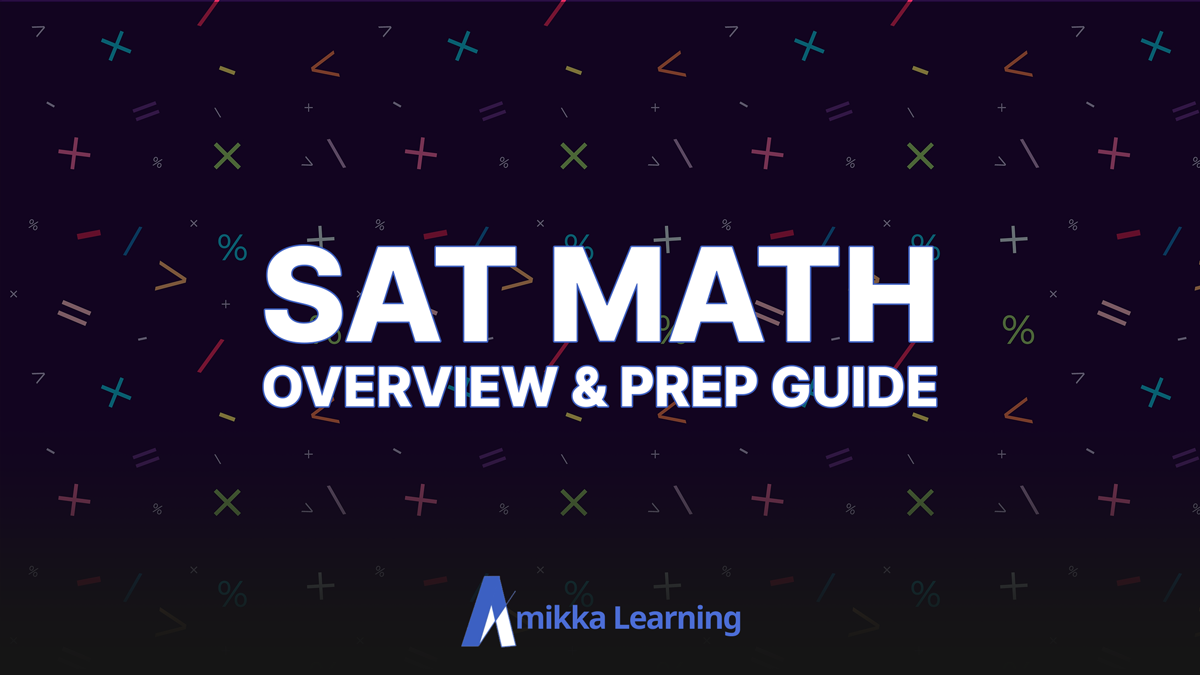


Written by Chris Hernandez
The SAT Math Test is a critical section of the SAT that evaluates how well you can utilize mathematical concepts and knowledge in a way that would be necessary for college or professional work.
There are two sections that are timed; the first section is 55 minutes long and allows the use of calculators, and it has 38 questions. The second section is 25 minutes long and does not permit the use of calculators, and it has 20 questions.
The rest of this article includes an overview of the SAT Math Test and a guide that will help you succeed when taking it.
In addition to evaluating your understanding of core topics, the exam will also evaluate your problem-solving capacity and capacity to use your knowledge in novel, complex, or unique ways.
It will focus specifically on your fluency with math, your grasp of the concepts, and your capacity to implement math skills.
The Math Test assesses different abilities in three primary math types:
Heart of Algebra: Focuses on your mastery of linear equations, systems of linear equations, and the relationships between them.
Problem-Solving and Data Analysis: Focuses on ratios, percentages, and proportional reasoning and assesses your general quantitative literacy.
Passport to Advanced Math: Features questions that require the manipulation and calculation of complex equations, focusing on complex equations and functions typically needed in a STEM-based—science, technology, engineering, and math—career.
Expect to encounter questions that belong to the Additional Topics in Math section. These questions may cover geometry, trigonometry, or other material related to college and career preparation.
The SAT Math Test contains questions that cover a range of everyday topics, such as jobs, science, and social science, as well as more specialized mathematical concepts like geometry, trigonometry, radian measure, and complex numbers.
The SAT Math test is 80 minutes long and requires you to answer 58 questions. The majority of these are multiple-choice, but there are also 13 grid-in questions that require a free-response answer. Some sections include multiple questions about a single subject, and others are single questions.
Here's the breakdown of time, number of questions, and question types on the two SAT math sections:
| Section | Number of Questions | Time Allowed |
| No Calculator | 15 Multiple Choice, 5 Grid-ins | 25 minutes |
| Calculator | 30 Multiple Choice, 8 Grid-ins (Including 1 extended thinking question) | 55 minutes |
| Total | 58 Questions | 80 minutes |
While you can only use a calculator in the longer math section, you'll have access to reference information for formulas to use in the geometry in both sections.
This part of the SAT usually follows the sections for Reading and Writing and Language, and it is the shortest of the sections, lasting only 25 minutes. Afterward, you will be afforded a brief five-minute break, allowing you to get your calculator out and prepare for the Math Calculator section.
You will be given 20 questions to answer, with an average of 75 seconds each.
Fifteen of these questions will have four possible answers to choose from, while the remaining five will be grid-ins, which you'll need to fill out on the designated portion of the answer sheet.
Here's how the Math No Calculator section breaks down exactly:
Since the No Calculator section of the Math part of the SAT is shorter than the other, it will only account for one-third of your total Math score.
Now, let's go beyond the details and talk about the abilities that will be tested in the Math No Calculator section.
There are no Problem-Solving and Data Analysis questions on the No Calculator section, in contrast to the Calculator section.
These questions require interpreting data from tables and scatter plots or determining ratios, rates, and proportions.
The chart below lists the quantity of questions from the three major skill areas.
| Math Type | Number of Questions | % of Section |
| Heart of Algebra | 8 | 40% |
| Passport to Advanced Math | 9 | 45% |
| Additional Topics | 3 | 15% |
Some questions have multiple steps and require you to combine two or more concepts to work toward a solution.
The calculator section is created to evaluate your knowledge of the real mathematical principles, rather than the risk of making mistakes with the calculations. In other words, it assesses the process that leads to the answer. This includes evaluating your familiarity with such topics as linear inequalities, interpretation of graphs/data, quadratic functions, geometry, and trigonometry.
The calculator is an invaluable resource, but it is important to know how and when to use it. The College Board suggests that all questions can be answered without the help of a calculator, so it should only be used for more complicated calculations. Before using your calculator, decide on the best way to solve the problem and then use it if necessary.
This section is clearly focused on linear equations, functions, and systems, which should be understood before more complex topics are studied. There is a high percentage of polynomial equations included. It is important for students to be familiar with the questions from the Heart of Algebra section before attempting the more advanced Passport questions, as these build on the concepts already covered. There are 16 of these questions out of 58 math questions on the actual test.
You may be asked to:
The test contains questions that are scattered evenly across the other sections, and have varying levels of difficulty. It will include both multiple-choice and open-ended questions, which can be challenging for some students. If you find this type of question difficult, it is wise to focus on areas where you need the most improvement while studying.
Proper SAT Math Test preparation is essential for any student looking to score well on the exam. Taking the time to review and practice the material covered on the SAT Math Test can help students gain confidence and familiarity with the content and format of the exam, giving them a leg up and the ability to reach their desired score.
The Evidence-Based Reading and Writing portion of the SAT primarily focuses on testing one's ability to think critically and apply knowledge. However, the SAT Math test covers more concrete content that you must be familiar with to do well.
It can be daunting, but chances are you have encountered some of this material during your high school math classes. To better understand the concepts, it would be beneficial to go over a structured study guide or review the tutorials from Amikka Learning, which can help you link the material to what you are already familiar with.
On the test, you will also have access to the list of formulas shown below that have been provided. To get the best score possible, you must understand how each formula works and when it should be used. Make sure you become comfortable with the formulas before test day.

To avoid making careless mistakes, it is essential to take your time while reading each question and consider your answer thoroughly. Additionally, it is recommended to write down the steps of a multi-step problem as you are working through it. This will make it easier to go back and double-check your work if you come up with an answer that is not one of the choices given.
For the SAT, you should strive to answer all the questions correctly, even the simpler ones, to avoid making mistakes that do not accurately reflect your true ability. Don't rush, but take your time to make sure you get the right answer.
When taking the test, set a goal for yourself and understand the steps needed to reach it. Let's say you want to get a 750 on the Math Test – you can't answer more than four questions incorrectly. If you come across a question that you have no idea how to solve, make an educated guess or skip up to four of them and come back later if you still have time.
It is important to understand that if you want to make use of this approach, you must be absolutely sure that the answers you do provide are correct. You can use the time saved by not attempting or making an educated guess at the hard questions to double-check the other responses you've given, thus maximizing your score.
When you take a test with multiple-choice answers, it is a straightforward process to find an unknown variable. Start by putting each answer choice into the equation and see if it works. Consider the value that appears to be the most sensible to you and work from there. Additionally, if you need to determine the association between two unknown variables in an equation, try inserting an uncomplicated value for one of them and see how it affects the value of the other variable relative to it.
Many word problems can be difficult to understand, as they sometimes contain a lot of information that is not essential or ask questions in a complicated manner. To tackle them, come up with a plan that includes highlighting any important numbers, crossing out numbers that aren't, and circling keywords that indicate the type of mathematical operation to be used. For example, words such as 'each,' 'every,' or 'per' often indicate that a rate needs to be calculated, which means you will probably need to use either multiplication or division.
Ensure you are familiar with Grid-In Questions before your exam so that you don't have to take the time to read the directions on the day of the test. Taking the time to review the Grid-In Questions outline before the test will help you move quickly when you get to these questions during the exam.
For some questions in the Math Test, you will be asked to solve the problem and enter your answer in the grid.
Directions for answering student-produced response questions are in the test book, but it is wise to take the time to be comfortable with the format before test day. Carefully read the directions for answering these questions. The directions explain what you can and can’t do when entering your answers on the answer sheet.
The rules are described below.
There is nothing as important as being ready when you walk into the test locale. So, going through one more list of SAT math tips can take you one step closer to being accepted into your dream school.
The SAT Math test is an important exam, and being thoroughly prepared for it is essential to achieve a good score. Taking practice tests, reviewing sample questions, and arranging SAT prep tutoring are all important steps to ensure you're ready for the test. With the right preparation and practice, you can ensure that you're in the best position possible to do your best on the SAT Math test. It is only natural to feel overwhelmed by the Math Section in anticipation of an upcoming SAT test.